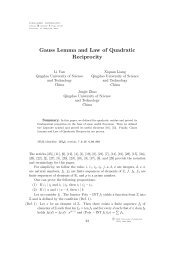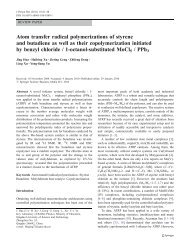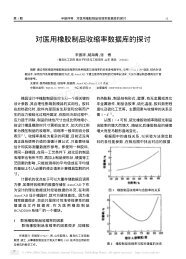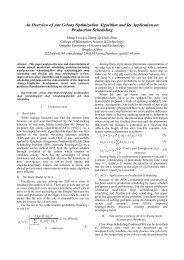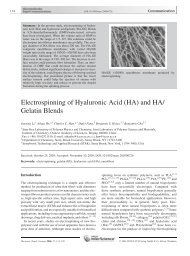Study on the Synthesis of Cyanex 301-Modified Fe2O3 Nanoparticles
Study on the Synthesis of Cyanex 301-Modified Fe2O3 Nanoparticles
Study on the Synthesis of Cyanex 301-Modified Fe2O3 Nanoparticles
- No tags were found...
Create successful ePaper yourself
Turn your PDF publications into a flip-book with our unique Google optimized e-Paper software.
Journal <strong>of</strong> Dispersi<strong>on</strong> Science and Technology, 30:1203–1207, 2009Copyright # Taylor & Francis Group, LLCISSN: 0193-2691 print=1532-2351 <strong>on</strong>lineDOI: 10.1080/01932690802701796<str<strong>on</strong>g>Study</str<strong>on</strong>g> <strong>on</strong> <strong>the</strong> Syn<strong>the</strong>sis <strong>of</strong> <strong>Cyanex</strong> <strong>301</strong>-<strong>Modified</strong>Fe 2 O 3 <strong>Nanoparticles</strong>Huaqiang Shi, Xiaod<strong>on</strong>g Zhou, He Liu, Yusheng Lin, and Xun FuKey Laboratory <strong>of</strong> Eco-Chemical Engineering, Ministry <strong>of</strong> Educati<strong>on</strong>, College <strong>of</strong> Chemistry andMolecular Engineering, Qingdao University <strong>of</strong> Science and Technology, Qingdao, P. R. ChinaDownloaded By: [Fu, Xun] At: 09:11 9 August 2009Surface modified Fe 2 O 3 nanoparticles were successfully syn<strong>the</strong>sized via different <strong>the</strong>rmaltreatment <strong>of</strong> <strong>the</strong> Fe(OH) 3 precursor, which was obtained by <strong>the</strong> extracti<strong>on</strong>-precipitati<strong>on</strong> system.The Fe 3þ i<strong>on</strong>s were extracted into hexane by <strong>the</strong> extractant first, <strong>the</strong>n <strong>the</strong> extracted soluti<strong>on</strong>c<strong>on</strong>taining Fe(III) complex was precipitated with NaOH soluti<strong>on</strong>. The obtained Fe(OH) 3 precursorwas given different <strong>the</strong>rmal treatment, such as solvo<strong>the</strong>rmal reacti<strong>on</strong>, an intense refluxingboiling tetralin and calcine at air, respectively. The obtained Fe 2 O 3 nanoparticles were characterizedby XRD, TEM, SEM, IR, UV-vis, and TG-DTG, respectively. The results showed thatFe 2 O 3 products were well modified by extractant, which could be well dispersed into organicsolvents to form <strong>the</strong> stable fluids.KeywordsChemical syn<strong>the</strong>sis, composite, electr<strong>on</strong> microscopy, magnetic material1. INTRODUCTIONFerr<strong>of</strong>luids is a unique and novel class <strong>of</strong> ferromagneticliquids in which inorganic magnetic materials are dispersedin a liquid to form a stable colloidal dispersi<strong>on</strong> that exhibitsmagnetic properties when a magnetic field is applied. [1–3]Ferr<strong>of</strong>luids has important applicati<strong>on</strong>s in <strong>the</strong> fileds suchas magnetocalor power cycle, [4] magnetoviscous effect, [5]magnetic imaging, [6] magnetic, [7] and magnetooptic datastorage media, [8] biology and medicine, [9] formati<strong>on</strong> <strong>of</strong>multilayered magnetic films, [10] and so <strong>on</strong>.During <strong>the</strong> past few years, lots <strong>of</strong> methods for <strong>the</strong>preparati<strong>on</strong> <strong>of</strong> Fe 2 O 3 particles (not ferr<strong>of</strong>luids) have beenexplored, such as sol-gel method, [11] hydro<strong>the</strong>rmal, [12]refluxing forced hydrolysis method, [13] and so <strong>on</strong>. Thecomm<strong>on</strong> ferr<strong>of</strong>luids, comprising a colloidal dispersi<strong>on</strong> <strong>of</strong>magnetite fine particles in an aqueous, were easily obtainedei<strong>the</strong>r by acid peptizati<strong>on</strong> <strong>of</strong> magnetite or by immobilizati<strong>on</strong><strong>of</strong> small magnetiti particlees in <strong>the</strong> matrix <strong>of</strong> a watersoluble polymer. [14] Howerer, it is known to be a complexReceived 25 March 2008; accepted 17 April 2008.This work was financially supported by <strong>the</strong> foundati<strong>on</strong> <strong>of</strong>Ph.D. subjects 2005, P. R. China (No. 20050426003) and <strong>the</strong>Key Laboratory Foundati<strong>on</strong> <strong>of</strong> Eco-Chemical Engineering <strong>of</strong>Qingdao University <strong>of</strong> Science and Technology (No. KLECE2007-001). The authors thank Cytec Canada, Inc. for its kindlysupplying <strong>the</strong> extractant <strong>of</strong> <strong>Cyanex</strong> <strong>301</strong>.Address corresp<strong>on</strong>dence to Xun Fu, Key Laboratory <strong>of</strong>Eco-Chemical Engineering, Ministry <strong>of</strong> Educati<strong>on</strong>, College<strong>of</strong> Chemistry and Molecular Engineering, Qingdao University<strong>of</strong> Science and Technology, Qingdao 266042, P. R. China. E-mail:xunfu4483@hotmail.comproblem that how to prepare <strong>the</strong> ferr<strong>of</strong>uids in organicsolvents directly because <strong>of</strong> <strong>the</strong> coupling properties <strong>of</strong> <strong>the</strong>insoluble particles and organic phase. In order to reduce <strong>the</strong>surface energy <strong>of</strong> nanoparticles and enhance <strong>the</strong> dissoluti<strong>on</strong>capacity in organic solvent, <strong>the</strong> syn<strong>the</strong>sis <strong>of</strong> organic–inorganic composite materials has been paid much attenti<strong>on</strong>.[15] Duo to <strong>the</strong> chemical structure <strong>of</strong> modifying agent,it could be adsorbed <strong>on</strong> <strong>the</strong> surface <strong>of</strong> <strong>the</strong> particles andsimultaneously become solvated by <strong>the</strong> organic solvent.Recently, a novel n<strong>on</strong>hydrolytic route based <strong>on</strong> <strong>the</strong> <strong>the</strong>rmaldecompositi<strong>on</strong> <strong>of</strong> ir<strong>on</strong> complexes in <strong>the</strong> presence <strong>of</strong> a surfactanthas led to <strong>the</strong> formati<strong>on</strong> <strong>of</strong> surface modified Fe 2 O 3nanoparticles that were soluble in organic solvents. [16] <strong>Cyanex</strong><strong>301</strong> (di-(2,4,4-trimethylpentyl) dithiophosphinic acid)is <strong>on</strong>e <strong>of</strong> <strong>the</strong> industrial extractants and can extract a greatdeal <strong>of</strong> metals in a wide scope <strong>of</strong> aqueous acidity, [17] whosestructure is analogous to <strong>the</strong> classical surfactant. Due toits high activity, <strong>the</strong> extractant was adsorbed <strong>on</strong>to <strong>the</strong> surface<strong>of</strong> <strong>the</strong> particles, promoting <strong>the</strong> particles stabilizati<strong>on</strong>. [18]In this work, a simple method was described to preparesurface-modified magnetic Fe 2 O 3 nanoparticles. Theobtained Fe 2 O 3 nanoparticles was well modified by <strong>Cyanex</strong><strong>301</strong> and <strong>the</strong> obtained particles could be easily dispersed inorganic solvents to provide stable fluid.2. EXPERIMENTAL2.1. Extracti<strong>on</strong> <strong>of</strong> Fe 3þ by <strong>Cyanex</strong> <strong>301</strong> and <strong>the</strong>Preparati<strong>on</strong> <strong>of</strong> Fe(OH) 3 –<strong>Cyanex</strong> <strong>301</strong> Precursor<strong>Cyanex</strong> <strong>301</strong> was supplied by Cytec Co. <strong>of</strong> Canada andused without fur<strong>the</strong>r purificati<strong>on</strong>. FeCl 3 6H 2 O and o<strong>the</strong>r1203
1204 H. SHI ET AL.Downloaded By: [Fu, Xun] At: 09:11 9 August 2009chemicals used in this work are analytical purity. First,FeCl 3 aqueous soluti<strong>on</strong> (with definite c<strong>on</strong>centrati<strong>on</strong>) isextracted into hexane by <strong>the</strong> extractant <strong>Cyanex</strong> <strong>301</strong> atVo=Va ¼ 1. The distributi<strong>on</strong> ratio is determined from <strong>the</strong>Fe 3þ c<strong>on</strong>centrati<strong>on</strong>s in <strong>the</strong> aqueous soluti<strong>on</strong>s before andafter extracti<strong>on</strong>. After phase separati<strong>on</strong>, <strong>the</strong> organic phasec<strong>on</strong>taining Fe(III)-<strong>Cyanex</strong> <strong>301</strong> complex is precipitateddirectly with NaOH soluti<strong>on</strong> under str<strong>on</strong>g stirring. Up<strong>on</strong><strong>the</strong> additi<strong>on</strong> <strong>of</strong> NaOH, <strong>the</strong> color <strong>of</strong> <strong>the</strong> organic phaseturned gradually from black to brown or red. Afterevaporati<strong>on</strong> <strong>of</strong> <strong>the</strong> solvents, <strong>the</strong> red substance is washedwith hot acet<strong>on</strong>e and ethanol alternatively, and dryingat 70 C.2.2. Preparati<strong>on</strong> <strong>of</strong> Fe 2 O 3 <strong>Nanoparticles</strong> via <strong>the</strong>Thermal TreatmentThe obtained Fe(OH) 3 –<strong>Cyanex</strong> <strong>301</strong> precursor was givendifferent <strong>the</strong>rmal treatment to obtain suface modifiedFe 2 O 3 nanoparticles.1. Thermal refluxing: The Fe(OH) 3 –<strong>Cyanex</strong> <strong>301</strong> precursorwas suspended in 40 ml tetralin and <strong>the</strong> suspensi<strong>on</strong> wassubjected to an intense refluxing (at <strong>the</strong> boiling point<strong>of</strong> tetralin 210 C) under arg<strong>on</strong> flow for 9 hours. Theobtained brown soluti<strong>on</strong> was cooled to room temperatuenaturelly and an excess <strong>of</strong> acet<strong>on</strong>e was added intoit. A brown precipitate formed immediately, whichwas isolated by centrifugati<strong>on</strong>.2. Calcining: The obtained Fe(OH) 3 –<strong>Cyanex</strong> <strong>301</strong> precursorwas calcined in a tube at 600 C at air for 2 hoursand <strong>the</strong> red powder was obtained.3. Solvo<strong>the</strong>rmal process: 35 mL <strong>of</strong> <strong>the</strong> above organic phasec<strong>on</strong>taining Fe(OH) 3 –<strong>Cyanex</strong> <strong>301</strong> precursor was transferredinto a 50 ml Tefl<strong>on</strong>-lined stainless autoclave.The red samples were obtained in autoclave after <strong>the</strong>reacti<strong>on</strong> was went <strong>on</strong> for 24 hours at 180 C. The aboveFe 2 O 3 particles were filtered, washed, dried, anddispersed into organic solvents again with <strong>the</strong> help <strong>of</strong>ultras<strong>on</strong>ic.3. RESULTS AND DISCUSSIONEqual volumes <strong>of</strong> 0.04 mol L 1 FeCl 3 aqueous soluti<strong>on</strong>and 0.10 mol L 1 <strong>Cyanex</strong> <strong>301</strong> hexane were mixed, shakenfor several minutes and equilibrated l<strong>on</strong>ger than 24 hoursat room temperature. The c<strong>on</strong>centrati<strong>on</strong>s <strong>of</strong> Fe 3þ i<strong>on</strong>s in<strong>the</strong> aqueous soluti<strong>on</strong>s before and after extracti<strong>on</strong> weredetermined by EDTA titrati<strong>on</strong>. It could been c<strong>on</strong>firmedthat <strong>the</strong> extracti<strong>on</strong> ratio reached about 100% and <strong>the</strong>Fe 3þ i<strong>on</strong>s in <strong>the</strong> aqueous soluti<strong>on</strong> was efficiently transferredinto hexane in our preliminary experiments.Figure 1 showed <strong>the</strong> XRD patterns <strong>of</strong> <strong>the</strong> as-preparedFe(OH) 3 -<strong>Cyanex</strong> <strong>301</strong> precursor (a), Fe 2 O 3 particles afteran intense influxing in boiling tetralin (b) and calcined at600 C (c) <strong>of</strong> <strong>the</strong> precursor. It could be seen that <strong>the</strong>obtained precursor (a) was Fe(OH) 3 according to <strong>the</strong>JCPDS card (No. 34-1266) although <strong>the</strong> crystallinity wasrelatively poor. The XRD patterns showed three broadweak envelope at about 2h ¼ 16 , 34 , and 62 , whichapproximately indexed to (200), (400), and (002) crystalgraphicplanes. The crystallinity <strong>of</strong> <strong>the</strong> products could begreatly improved by different <strong>the</strong>rmal treatments. Themain peaks <strong>of</strong> <strong>the</strong> influxed (b) and <strong>the</strong> calcined (c) samplesmatched well with <strong>the</strong> standard positi<strong>on</strong>s JCPDS cardNo. 25-1402 and No. 33-664, respectively.Figure 2 showed <strong>the</strong> TEM, SEM images, and <strong>the</strong> relatedelectr<strong>on</strong> diffracti<strong>on</strong> (ED) patterns <strong>of</strong> <strong>the</strong> as-preparedFe(OH) 3 –<strong>Cyanex</strong> <strong>301</strong> precursor (a), Fe 2 O 3 nanoparticlesafter an intense influxing (b), calcined at 600 C (c, d) andsolvo<strong>the</strong>rmal process (e) <strong>of</strong> <strong>the</strong> above precursor. It couldbe seen that <strong>the</strong> Fe(OH) 3 –<strong>Cyanex</strong> <strong>301</strong> precursor (a) wasmainly made up <strong>of</strong> sphere-like polycrystal materials, whichwas formed from radially aligned Fe(OH) 3 . After anintense influxing (b), <strong>the</strong> radially aligned Fe(OH) 32.3. Characterizati<strong>on</strong> <strong>of</strong> Surface <strong>Modified</strong>Fe 2 O 3 <strong>Nanoparticles</strong>The morphologies and size <strong>of</strong> <strong>the</strong> Fe 2 O 3 nanoparticleswere observed by transmissi<strong>on</strong> electr<strong>on</strong> microscopy(TEM; JEM-2000EX, Japan) and scanning electr<strong>on</strong> microscopy(SEM; JSM-5600LV, Japan). The x-ray powderdiffracti<strong>on</strong> (XRD) pattern <strong>of</strong> <strong>the</strong> products was recordedby employing a Rigaku (Japan) D=max r-A x-ray diffractometerwith Cu=Ka radiati<strong>on</strong> (k ¼ 0.15418 nm). The solidsamples were also characterized with ultraviolet-visibleabsorpti<strong>on</strong> spectra (UV-vis; 756CRT, China), infraredray (IR; 510P, USA) and <strong>the</strong>rmal gravimetric analysis(TG; TG-209, Germany), respectively.FIG. 1. XRD patterns <strong>of</strong> <strong>the</strong> as-prepared Fe(OH) 3 –<strong>Cyanex</strong> <strong>301</strong> precursor(a), Fe 2 O 3 nanoparticles after influx in tetralin (b) and calcinedat 600 C (c) <strong>of</strong> <strong>the</strong> precursor.
CYANEX <strong>301</strong>-MODIFIED <strong>Fe2O3</strong> NANOPARTICLES 1205Downloaded By: [Fu, Xun] At: 09:11 9 August 2009above could be easily dispersed into organic solvents.While <strong>the</strong> obtained Fe 2 O 3 sample (e) was <strong>of</strong> sheet-likestructure with size <strong>of</strong> about 100200 nm after solvo<strong>the</strong>rmaltreatment at 180 C, which ED pattern shows that <strong>the</strong>samples were polycrystals.Figure 3 showed <strong>the</strong> IR spectra <strong>of</strong> <strong>the</strong> as-preparedFe(OH) 3 –<strong>Cyanex</strong> <strong>301</strong> precursor (a), Fe 2 O 3 nanoparticlesafter an intense influxing (b) and calcined (c) <strong>of</strong> <strong>the</strong> aboveprecursor. The absorpti<strong>on</strong> peaks at 2955 cm 1 and2395 cm 1 were attributed to <strong>the</strong> stretched vibrati<strong>on</strong> <strong>of</strong>C–H and S–H, respectively. The absorpti<strong>on</strong> peaks at1475 cm 1 and 1365 cm 1 were attributed to <strong>the</strong> splitting<strong>of</strong> tert-butyl. The absorpti<strong>on</strong> peaks at 488 cm 1 and612 cm 1 were attributed to <strong>the</strong> P–S–H and P¼S in extractant<strong>Cyanex</strong> <strong>301</strong>. [19] The typical peaks in <strong>Cyanex</strong> <strong>301</strong> mostexisted in Fe(OH) 3 precursor (a) and Fe 2 O 3 nanoparticles(b, c), indicating that <strong>Cyanex</strong> <strong>301</strong> adsorbed <strong>on</strong> <strong>the</strong> surface<strong>of</strong> Fe 2 O 3 particles could not be washed <strong>of</strong>f totally. The stabilizingfuncti<strong>on</strong> is expected to be similar to that <strong>of</strong> thiolligands. Moreover, as shown in Figure 3a, <strong>the</strong> frequencyseparati<strong>on</strong> between 1508 and 1355 cm 1 indicates that <strong>the</strong><strong>Cyanex</strong> <strong>301</strong> molecule bind <strong>the</strong> surface ir<strong>on</strong> centers inchelating <strong>of</strong> bridging mode <strong>of</strong> coordinati<strong>on</strong>. The bands at600 cm 1 and 464 cm 1 were indicative <strong>of</strong> an ir<strong>on</strong> oxidehydroxide network. [20] After <strong>the</strong>rmal treatment <strong>of</strong> Fe(OH) 3 –<strong>Cyanex</strong> <strong>301</strong> precursor, <strong>the</strong> characteristic bands <strong>of</strong> <strong>the</strong><strong>Cyanex</strong> <strong>301</strong> groups were still observable, while an enhancement<strong>of</strong> <strong>the</strong> band at 600 cm 1 was also observed. Theseresults unveil <strong>the</strong> preservati<strong>on</strong> <strong>of</strong> <strong>the</strong> organophilic sheatharound <strong>the</strong> magnetic solid and also <strong>the</strong> formati<strong>on</strong> <strong>of</strong> ir<strong>on</strong>oxide network. [21]Figure 4 shows <strong>the</strong> UV-vis absorpti<strong>on</strong> spectra <strong>of</strong> <strong>the</strong>as-prepared Fe(OH) 3 –<strong>Cyanex</strong> <strong>301</strong> precursor (a), Fe 2 O 3nanoparticles after an intense influxing (b) and calcined(c) <strong>of</strong> <strong>the</strong> precursor. The absorpti<strong>on</strong> band at about215 nm in (a) should be attributed to <strong>the</strong> b<strong>on</strong>d <strong>of</strong> P¼S inFIG. 2. TEM and SEM images <strong>of</strong> <strong>the</strong> Fe(OH) 3 –<strong>Cyanex</strong> <strong>301</strong> precursor(a), Fe 2 O 3 nanoparticles after influxing (b), calcined (c, d) andsolvo<strong>the</strong>rmal treatment (e).disappeared and <strong>the</strong> hydrolysis sample was polycrystalFe 2 O 3 nanoparticles with <strong>the</strong> diameter <strong>of</strong> about 100 nm.As shown in (c, d), <strong>the</strong> single crystal Fe 2 O 3 nanoparticleswith <strong>the</strong> diameter <strong>of</strong> less than 100 nm have been obtainedafter calcinati<strong>on</strong> at 600 C. Due to <strong>the</strong> good modificati<strong>on</strong>effect <strong>of</strong> <strong>Cyanex</strong> <strong>301</strong>, <strong>the</strong> obtained Fe 2 O 3 samples menti<strong>on</strong>FIG. 3. IR spectra <strong>of</strong> <strong>the</strong> Fe(OH) 3 –<strong>Cyanex</strong> <strong>301</strong> precursor (a), Fe 2 O 3particles after influxing (b) and calcined (c) <strong>of</strong> <strong>the</strong> precursor.
CYANEX <strong>301</strong>-MODIFIED <strong>Fe2O3</strong> NANOPARTICLES 1207procedure. The obtained Fe 2 O 3 nanoparticles were wellmodified by <strong>Cyanex</strong> <strong>301</strong> and could be dispersed well intoorganic solvents again due to <strong>the</strong> high affinity with n<strong>on</strong>polarsolvent with <strong>the</strong> R groups in <strong>Cyanex</strong> <strong>301</strong>. Thismethod provides a good idea for preparing ferr<strong>of</strong>luidsdirectly in organic solvent for industry.Downloaded By: [Fu, Xun] At: 09:11 9 August 2009FIG. 6. TEM images <strong>of</strong> <strong>the</strong> Fe 2 O 3 nanoparticles obtained in 1 mol L 1(a) and 4 mol L 1 (b) NaOH soluti<strong>on</strong>.3.1. Solubility <strong>of</strong> <strong>the</strong> Surface <strong>Modified</strong> Fe 2 O 3<strong>Nanoparticles</strong> in Organic SolventsThe as-prepared Fe 2 O 3 nanoparticles modified with<strong>Cyanex</strong> <strong>301</strong>, which were obtained from an intense influxingin boiling tetralin <strong>of</strong> <strong>the</strong> Fe(OH) 3 -<strong>Cyanex</strong> <strong>301</strong> precursor.With <strong>the</strong> help <strong>of</strong> ultras<strong>on</strong>ic, <strong>the</strong> obtained Fe 2 O 3 nanoparticlescould be dispersed easily into organic solvents, such ashexane and toluene. In hexane solvent, <strong>the</strong> dissoluti<strong>on</strong>process proceeds rapidly and leads to clear and transparentbrown organosols. There was no obvious precipitate after<strong>the</strong> obtained brown organosols was centrifugating at3000 r=min for 30 minutes and it remain stable even aftermore than 2 m<strong>on</strong>th in our lab at room temperature. Theabove results were well in agreement with <strong>the</strong> IR, UV,and TG-DSC analysis results. When <strong>the</strong> as-prepared surfacemodified Fe 2 O 3 nanoparticles after calcined at 600 Cwere redispersed into hexane solvent, <strong>the</strong> dissoluti<strong>on</strong> capacitydecreased obviously and <strong>the</strong>re is a little <strong>of</strong> precipitateafter a centrifugating process. It was c<strong>on</strong>sidered that someR groups in <strong>Cyanex</strong> <strong>301</strong> <strong>on</strong> <strong>the</strong> surface <strong>of</strong> Fe 2 O 3 nanoparticleswas decomposed during <strong>the</strong> calcined process. Thismight imply that <strong>the</strong> R groups in <strong>Cyanex</strong> <strong>301</strong> have a higheraffinity with n<strong>on</strong>polar solvent.4. CONCLUSIONSurface modified Fe 2 O 3 nanoparticles were successfulllysyn<strong>the</strong>sized via <strong>the</strong> different <strong>the</strong>rmal treatments from <strong>the</strong>Fe(III)–<strong>Cyanex</strong> <strong>301</strong> precursor, such as solvo<strong>the</strong>rmal reacti<strong>on</strong>in Tefl<strong>on</strong>-lined stainless autoclave, an reflux in boilingtetralin for 9 hours and calcine at 600 C under air for2 hours. The extractant <strong>Cyanex</strong> <strong>301</strong> acted as phase transferagent and surface modifying agent during <strong>the</strong> wholeREFERENCES[1] Tr<strong>on</strong>c, E., Chanéac, C., and Jolivet, J.P. (1998) J. Solid StateChem., 139(1): 93–104.[2] Wormuth, K. (2001) J. Colloid Interface Sci., 241(2):366–377.[3] De Cuyper, M. and Noppe, W. (1996) J. Colloid InterfaceSci., 182(2): 478–482.[4] Jing, Z.H. and Wu, S.H. (2004) J. Solid State Chem.,177(4–5): 1213–1218.[5] Hall, W.F. and Busenberg, S.N. (1969) J. Chem. Phys., 51(1):137–144.[6] Goto, K. and Sakurai, T. (1977) Appl. Phys. Lett., 30(7):355–356.[7] Speliotis, D.E. (1997) In Magnetic Hysteresis in NovelMagnetic Materials, edited by G.C. Hadjipanayis; NATOASI Series, Ser. E: Applied Sciences; Dordrecht, Germany:Kluwer: vol. 338, p. 259.[8] Sellmayer, D.J. In Nanophase Materials-Syn<strong>the</strong>sis-Properties-Applicati<strong>on</strong>s, edited by G.C. Hadjipanayis andW. Siegel NATO ASI Series, Ser. E: Applied Sciences;Dorcrect, , Germany: Kluwer, vol. 260, p. 537.[9] Arshady, R. (1993) Biomaterials, 14(1): 5–15.[10] Meldrum, F.C., Kotov, N.A., and Fendler, J.H. (1994)J. Phys. Chem., 98(17): 4506–4510.[11] da Costa, G.M., De Grave, E., de Bakker, P.M.A., andVandenberghe, R.E. (1994) J. Solid State Chem., 113(2):40–412.[12] Hiroyuki, I. and Sugimoto, T. (2003) J. Colloid Interface Sci.,265(2): 283–295.[13] Wei, Y., He, H.L. (1997) Acta Physico-Chimica Sinica, 13(6):564–568.[14] Yokoi, H. and Kantoh, T. (1993) Bull. Chem. Soc. Jpn.,66(5): 1536–1541.[15] Motte, L., Petit, C., Boulanger, L., Lix<strong>on</strong>, P. and Pileni, M.P.(1992) Langmuir, 8(4): 1049–1053.[16] Bourlinos, A.B., Simopoulos, A., and Petridis, D. (2002)Chem. Mater., 14(2): 899–903.[17] Sole, K.C. and Fea<strong>the</strong>r, A.M. (2005) Hydrometallurgy,78(1–2): 52–78.[18] S<strong>on</strong>g, X.Y., Sun, S.X., Zhang, W.M., and Yin, Z.L. (2004)J. Colloid Interface Sci., 273(2): 463–469.[19] Chen, J., Jiao, R.Z., and Zhu, Y.J. (1996) Chin. J. Appl.Chem., 13(2): 45–48.[20] Deac<strong>on</strong>, G.B. and Phillips, R. (1980) Coord. Chem. Rev.,33(3):227–250.[21] Nasrazadan, S. (1997) Corros. Sci., 39(10–11):1845–1859.





